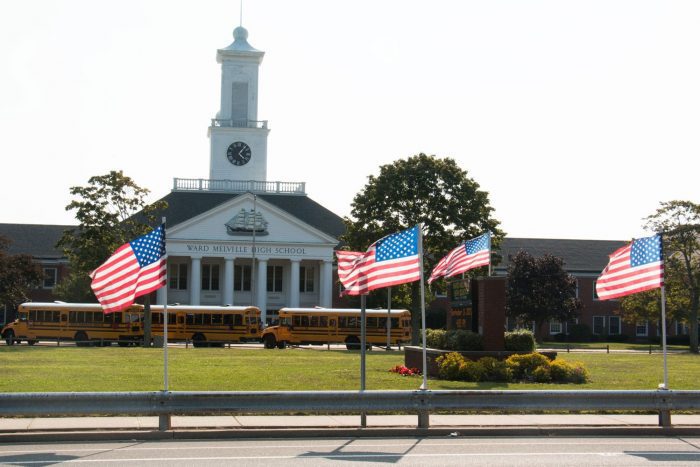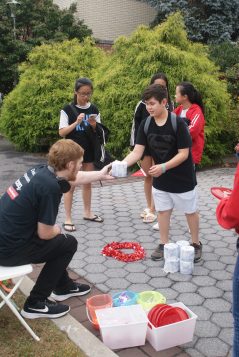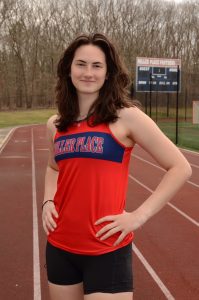By Mallie Jane Kim
Three Village Central School District officials shared the latest details in their plan to move ninth grade out of the junior high schools to create a four-year program at Ward Melville starting in the 2025-26 school year, in line with state and national norms.
The presentation at a Sept. 25 board meeting comes after more than two years of discussions over restructuring the district and after more than a year of planning.
“Everyone’s been putting their heads together to make this the best possible transition that it can be,” said Brian Biscari, assistant superintendent for educational services, who also touted the change as providing ninth graders access to additional courses outside the core academic subjects. “The ninth graders moving up to the high school are going to have more options for electives as well as activities they can participate in.”
The district also plans to move sixth grade from the elementary schools to the junior high schools, though an update on those plans will be forthcoming at a future board meeting.
In the presentation to the board, Ward Melville Principal John Holownia laid out some specifics: Core curriculum will remain the same for ninth graders, but electives will expand significantly. Currently the junior high schools offer nine half-year electives and eight full-year electives to ninth graders. Those numbers will jump to 29 and 13, respectively, with some of those electives reserved for ninth grade only.
“We’ll make sure that we have places to go to match their interests,” Holownia said, adding that electives will be contingent on budget and student interest, as is currently the process at the high school. “It’s not a guarantee that we run all of these classes year over year.”
Swimming as a part of physical education will continue to start in 10th grade, and there will be no change in course availability for grades 10-12, outside of the usual course review process.
Ward Melville staff plans to double transition supports and events, like hosting two separate orientation nights and new student walkthroughs.
Not everyone is thrilled about the upcoming changes. Some area parents have expressed on social media and in conversations around the district that the process has felt opaque. As recently as the public start-time forums, some expressed they did not even know the change had already been decided.
“It feels rushed,” wrote district parent Joanna Zalewski in an email read aloud during the public comment section of the board meeting. “We still lack information on crucial aspects such as building utilization, how the high school will handle the increased student population, and what specific academic or social benefits this change is supposed to bring.”
Zalewski said alignment with norms is not a compelling reason and called for delaying the move. “There is no state mandate requiring this change,” she wrote. “Nor is there one from the community.”
Superintendent of Schools Kevin Scanlon has long relied on the outcome of a 2023 survey as his guide for spearheading this change. The survey, which had more than 6,000 responses from among parents, staff, students and the broader community, indicated the majority of each stakeholder group preferred to move up sixth and ninth grades.
“This is going to create some tremendous opportunities for our students,” Scanlon said at the meeting. “This is going to put them on more of a par with their peers in other districts that they are competing with for positions, eventually, in colleges or the workforce.”
Flood damage to Nassakeag
More than a month after the “once-in-a-century” Aug. 19 storm, the district is still working on rehabilitating damage to Nassakeag Elementary School and finding ways to prevent future issues.
The school building itself sits lower than its surrounding land, and a loading dock essentially funneled more than 160,000 gallons of water straight into the boiler room, according to Interim Deputy Superintendent Jeffrey Carlson’s presentation at the board meeting.
Electrical panels and boiler controls were all submerged, and the auditorium as well as some classrooms had flooding.
“It was awful,” said Carlson, who praised the team of people who spent hours working to get the building ready for the start of the school year on Sept. 2. “We had industrial-sized dehumidifiers throughout the building for days and days, and a whole brigade of mop buckets. It was a mess.”
Initial estimates indicated the building would need a month of cleanup before it was fit for students, but district staff — who were honored with certificates at the start of the board meeting — worked overtime.
“If it wasn’t for the efforts of all these folks, we would not have had the building up and running in about a week and a half,” Scanlon said. “So we were able to open on time.”
The district plans to replace boiler controls “in the not-too-distant future” and to install watertight flood doors to prevent future water damage, leveraging state building aid and a FEMA claim to pay for it, according to Carlson.
One lingering mystery, possibly related to August’s flooding, was the failure of the concrete slab under two Nassakeag classrooms. School staff recently discovered the floor in those rooms had dropped down slightly.
District staff dug next to the foundations and discovered a void in that area. Carlson, who assured the board the issue was not structural and did not impact the walls or the ceiling, put forward several theories of how such a void could have formed under the 60-year-old school: Perhaps the building was built over felled trees, which rotted, or dirt washed away in an underground flow. Maybe the original builders didn’t compact the dirt enough, or the unusual April 5 earthquake with a light aftershock shifted the ground.
“We’re investigating,” Carlson said. “Hopefully we’ll be able to figure out exactly what caused that so we can prevent it from happening again, and see if there was anywhere else where this is maybe looming.”
In the meantime, students have been moved to alternate classrooms, and architects are working on a way to restore the concrete slab to make those rooms usable again.



 With its first celebration in 2012, National Voter Registration Day is a nonpartisan civic holiday dedicated to celebrating the democracy of America. It helps people register to vote and educates communities on the topics at hand, as well as the current office members. Since its inception, more than 5 million Americans have registered.
With its first celebration in 2012, National Voter Registration Day is a nonpartisan civic holiday dedicated to celebrating the democracy of America. It helps people register to vote and educates communities on the topics at hand, as well as the current office members. Since its inception, more than 5 million Americans have registered.













































